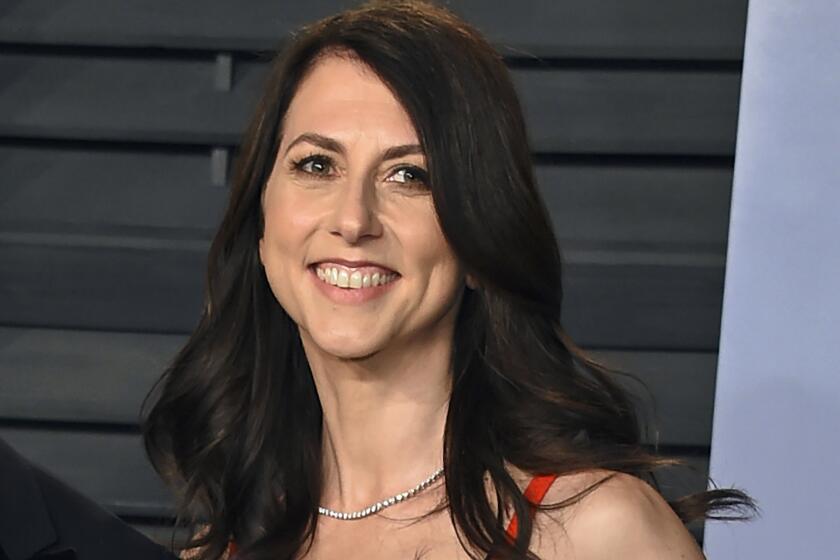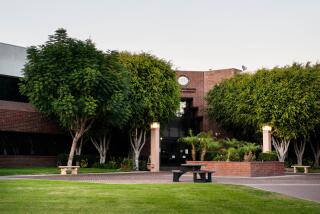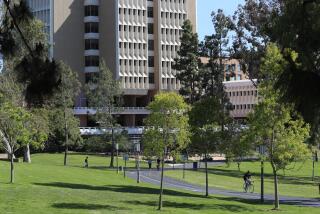Stanford receives $1.1 billion from John Doerr for climate crisis, sustainability school

- Share via
Stanford University will establish its first new school in 70 years, to focus on sustainability and the climate crisis, following a historic $1.1-billion donation from venture capitalist John Doerr.
The gift from Doerr and his wife, Ann, is the largest in the university’s history, and one of the largest donations ever made to an academic institution. Combined with nearly $600 million from other donors, the Stanford Doerr School of Sustainability will house departments related to climate change, Earth and planetary sciences, energy technology, sustainable cities, the natural environment, food and water security, human society and behavior, and human health and the environment.
The school, which will include the existing Stanford Woods Institute for the Environment and the Precourt Institute for Energy, will address short-term and long-term climate and sustainability issues. An accelerator program will focus on enabling technology-related projects and policy measures to address immediate environmental injustices; research will assess the impact of current innovations while anticipating future issues.
“We don’t know all the problems that we’re going to face in the future — we know what we know today. But fundamental research is going to discover some of the new issues that are going to come out and attack points of how to address them,” said the school’s inaugural dean, Arun Majumdar. “This organization reflects the needs and the demands of our time today.”
Majumdar said the school will work with fossil-fuel companies that meet the university policies, which evaluates companies’ ethical investment framework with regard to environmental damage.
MacKenzie Scott announced donations of $2.7 billion to 286 organizations. More than three dozen of the recipients in Scott’s latest round of giving are California community colleges and universities, arts groups and nonprofits that work for social justice.
“We need to remove tens of gigatons of CO2, if not hundreds of gigatons of CO2 and methane from the atmosphere. … Universities alone cannot do that,” Majumadar said, adding there is a willingness to work with companies that have committed to removing methane from the environment “whether it’s batteries, whether it’s solar cells, whether it’s different kinds of wind turbines or transmission systems, electricity markets and negative emissions of CO2.”
In May 2020, the university provost and president accepted a recommendation from a faculty committee to create the school. Stanford took the idea to the Doerrs, who agreed to make the donation, President Marc Tessier-Lavigne said. Doerr, a pioneering Silicon Valley venture capitalist, is known for leading investments in firms including Amazon, Google and Netscape.
While scientists and scholars at Stanford are already working on issues related to sustainability and climate change, the belief is that more can be accomplished with the sustainability school.
“The magnitude of that challenge demanded that we scale our efforts appropriately and to do that we needed to reorganize how we were focused,” Tessier-Lavigne said. “The younger generation is concerned about the fate of the planet and they want to be involved in a hands-on way. This creates opportunities for our undergraduate students, but also importantly for our master’s and PhD students as well.”
It’s a mission that hits close to home. Tessier-Lavigne, Majumdar and the Doerrs, who spoke to The Times Wednesday, all have daughters who are young adults passionate about sustainability and climate issues.
John Doerr said his daughters demanded that his generation restore the climate after watching Al Gore’s “An Inconvenient Truth.” This propelled the family to get involved with such issues, and he believes this focus on environmental issues is a way of the future in education.
“I think that we’re going to see sustainability and climate science be the new computer science. It’s going to create tremendous opportunity and satisfaction with a life well-lived and work well-done.”
The school will launch with 90 faculty members, with plans to expand to 150 over the next 10 years. The school will open on Sept. 1, Tessier-Lavigne said. A curriculum plan is currently underway.
More to Read
Sign up for Essential California
The most important California stories and recommendations in your inbox every morning.
You may occasionally receive promotional content from the Los Angeles Times.












